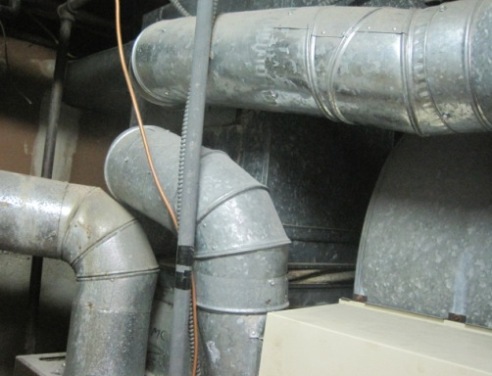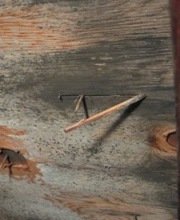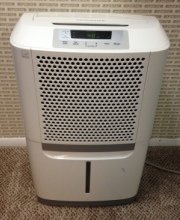Find a Mold Specialist Now
Click or Call, Toll-Free 24/7
Mold in heating ducts
Mold in heating ducts is a serious problem. Of course, household mold is never a good thing, no matter where in the home it's found. Exposure to mold has been linked to all sorts of health problems and it can literally eat away at some building materials, including wood. There are a few reasons mold in heating, ventilation and air conditioning ducts is particularly problematic, though. We'll tell you why it's such a bad thing and what to do if you think you may have mold in your heating ducts.
You Can't See It
Mold can grow unseen in heating ducts for a long time before you ever realize it's there. Even if you suspect you have mold in your home and look for it, you might miss mold in your heating ducts. It can be hard to see even if you try to look in your heating ducts, since only a small portion of the duct work in your home can be seen without special equipment. Even if you can't see it, though, mold in your heating ducts can grow and spread and make you sick.
It Can Easily Spread throughout the House
Most strains of mold grow and spread easily. The duct work that runs through your house provides a pathway for mold to move easily from room to room, throughout the whole house. Turning on the heat helps mold move through the duct work even faster, as the forced air carries the mold spores effortlessly along. Even worse, when the heat is turned on, the air blowing through the vents carries mold spores into every room. In no time at all, you could have mold throughout the entire house.
It Makes You Sick
Exposure to household mold has been linked to a wide range of health problems. Of course, it's not just mold in heating ducts that causes illness. Mold anywhere in your house can do that. Since mold spreads through heating ducts so rapidly, though, you'll soon be exposed to mold everywhere in your home. On top of that, every time the heat is turned on, mold spores will drift through the air, where they are easily inhaled.
Inhaling mold spores can trigger asthma attacks and cause coughing, sneezing, difficulty breathing, sore throats, sinus infections, bronchitis and pneumonia. According to the U.S. Centers for Disease Control and Prevention (CDC), exposure to mold has been found to cause asthma, a lifelong respiratory condition for which there is no cure, in small children. Exposure to one strain of mold, stachybotrys chartarum (sometimes referred to as black mold), has been linked to pulmonary hemorrhage in infants, a complication that is sometimes fatal.
 Heating ducts near forced hot air gas furnace
Heating ducts near forced hot air gas furnaceMold in Heating Ducts Is Difficult to Remove
It's one thing to clean mold off shower stalls or to remove moldy carpet from a room. It is another thing to remove mold in heating ducts. While mold can be removed from nonporous surfaces like metal or fiberglass heating ducts, it's difficult to reach the ducts in order to clean them.
The U.S. Environmental Protection Agency (EPA) recommends calling in a professional if you need to have mold removed from your heating ducts and we definitely agree. Special equipment is needed for the job, including manual or mechanical brushes, blowguns or air skippers that drive mold particles and other debris toward a collection device, a vacuum with a HEPA (high-efficiency particulate air) filter to remove potentially harmful mold and other contaminants from the heating ducts, and negative air pressure devices that create negative pressure within the duct work so that mold spores are unable to drift into other areas during the mold removal process. The job must also be done carefully in order to avoid inadvertently damaging the duct work in the process.
Look for a professional that is certified by, or at least adheres to the standards established by, the National Air Duct Cleaners Association. If you have fiberglass ducts or fiberglass liners in your ducts, look for a professional that also is familiar with and follows the cleaning procedures established by the North American Insulation Manufacturers Association (NAIMA). Many techniques commonly used to clean heating ducts can damage fiberglass, so it is important to choose a professional with the skills and experience needed to properly clean fiberglass ducts.
Until you can get a professional to look at your heating ducts, don't turn on the heat! Running your furnace will cause mold to spread and also increase your risk of mold-related illness.
Making Sure Mold in Heating Ducts Has Been Removed Completely
The Environmental Protection Agency suggests having your home tested for mold after mold remediation has been completed and we think that is especially important after having mold removed from your heating ducts. You want to make sure no mold remains in the duct work because if even a little bit of mold remains, it can grow and spread throughout the home again. Make sure you find a professional mold tester that adheres to the standards established by professional organizations like the American Industrial Hygiene Association or the American Conference of Governmental Industrial Hygienists. This link will help you find qualified mold testers in your area.
Note that you want to hire a professional mold tester who is not affiliated in any way with any company or professional performing mold remediation in your home or cleaning the heating ducts in your home. You want someone completely independent and objective.
Inspecting for Mold
Having your heating ducts cleaned may not be enough to ensure your home is free of potentially hazardous mold. Since mold spreads easily, especially through heating ducts, we recommend checking the rest of your home for mold. A professional mold tester can test the rest of your home or you can schedule a free inspection by a mold removal specialist. If any additional mold is found, the mold removal professional will provide a written estimate for the work and answer any questions you may have. To find qualified mold removal professionals offering free inspections in your area, just follow the link.
Additional Reading:
Mold in Window Air Conditioner - How to know if you have mold in a window AC unit. Dealing with mold, cleaning vs replacing, air quality concerns.
Mold in Central AC Systems - Finding mold in an AC system, health issues, removal.
Return From Mold In Heating Ducts To Home Page
Ref:
EPA: Testing & Sampling
Privacy Policy Terms and Conditions Accessibility Do Not Sell My Information Disclaimer Contact Us




